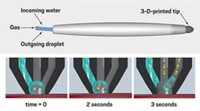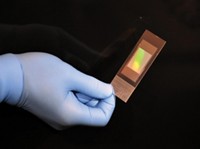Advertisement
Grab your lab coat. Let's get started
Welcome!
Welcome!
Create an account below to get 6 C&EN articles per month, receive newsletters and more - all free.
It seems this is your first time logging in online. Please enter the following information to continue.
As an ACS member you automatically get access to this site. All we need is few more details to create your reading experience.
Not you? Sign in with a different account.
Not you? Sign in with a different account.
ERROR 1
ERROR 1
ERROR 2
ERROR 2
ERROR 2
ERROR 2
ERROR 2
Password and Confirm password must match.
If you have an ACS member number, please enter it here so we can link this account to your membership. (optional)
ERROR 2
ACS values your privacy. By submitting your information, you are gaining access to C&EN and subscribing to our weekly newsletter. We use the information you provide to make your reading experience better, and we will never sell your data to third party members.
Analytical Chemistry
Sorting Cells From Whole Blood
Medical Diagnostics: A microfluidic device that separates rare cells could help diagnose cancer
by Corinna Wu
January 20, 2012

Finding one cancer cell floating in a sea of a billion blood cells is like searching for the proverbial needle in a haystack. But now researchers have shown that they can efficiently sort rare cells from whole blood using a microfabricated lab on a chip (Anal. Chem., DOI: 10.1021/ac2022844).
Because tumors shed cells that circulate in the bloodstream, scientists have been developing ways to detect and characterize those cells. Such methods would help both diagnose disease and monitor a patient’s progress during treatment. But because the cells circulate in such small numbers, it’s challenging to find and sort them from a blood sample.
Shashi Murthy of Northeastern University and colleagues miniaturized a well-established technique called magnet-activated cell sorting, or MACS. In MACS, microscopic magnetic beads attached to antibodies tag the desired cells. The sample then runs through a magnetic field to separate tagged from untagged cells. Shrinking MACS, says Murthy, makes it “a lot more practical and sensitive at same time.”
Murthy and his colleagues first did calculations that modeled the movement and behavior of magnetically tagged cells in a microfabricated MACS device. They then based the design of their device, which is the size of a business card, on the calculations.
The researchers tested their device on whole human blood spiked with magnetically tagged breast cancer cells at a concentration of 50 cells per mL, a level at the lower end of reported concentrations of patients’ circulating cancer cells. The device was able to recover 95% of the cells.
As long as doctors know of antibodies that can affix the magnetic tags to particular cancer cells, the microfluidic cell sorter could find use diagnosing cancer at an early stage, when just a few cancer cells are circulating in the blood, Murthy says. It could also collect rare cells for researchers to culture in the lab, since the cells come out alive and intact. Murthy’s team showed that their device can separate stem cells from blood for use in treatments or in the lab.
Samuel Forry, an analytical chemist at the National Institute of Standards and Technology, admires the device’s rational design, which he says should allow numerous applications: Researchers could adapt the system to separate cells in saliva or lymph fluid, for example. “Shashi’s group has taken a very strong engineering approach to this clinically relevant question,” he says.
What’s more, Forry says, the device should be easy and economical to use. Some of the parts are disposable, he notes, while others, which are more expensive to fabricate, can be reused. “The end product is very approachable for non-experts to use,” he says.





Join the conversation
Contact the reporter
Submit a Letter to the Editor for publication
Engage with us on Twitter